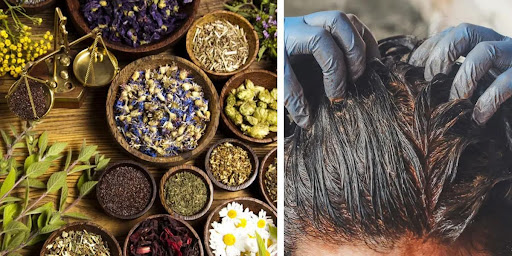
Modern hair dyes rely heavily on challenging chemicals like ammonia and parabens to open cuticles and deposit lasting color. But enduring traditional knowledge reveals safer, equally effective botanical alternatives.
Practiced in India for thousands of years, the holistic healing system of Ayurveda utilizes native plants according to their innate benefits. Infusing certain natural ingredients into beneficial oils allows them to gently seep into hair and alter pigmentation.
Getting to know classics like henna, amla, and indigo offers beginners a primer before trying heritage recipes. Soon you can transform dull, greying strands into lush, luminous locks with Ayurvedic hair color blends mixed up at home.
Understanding the Power of Ayurvedic Herbs for Hair
Essentially translating to “the knowledge of life”, Ayurveda focuses on synergizing physical, mental, and social health through personalized practices centered around balance. Adapting habits to align with personal doshas counteracts forces of chaos. Detecting deficiencies also enables one to pinpoint areas needing support. In terms of hair beauty regimens,
Ayurveda classifies locks as a powerful byproduct of bone marrow tissue reflecting inner calm. Promoting optimal growth through scalp oils subsequently anchors energy. But while essential hair oils feed follicles, complementary coloring herbs refresh hue. Three classic pigment hair naturally sans chemicals of Ayurvedic Hair Colour are listed below.
Henna: Vibrant Reddish Orange Tint
Derived from a flowering bush, henna (Lawsonia inermis) imparts a rich reddish-brown stain. Lawsone molecules from leaves bond safely with the keratin protein in the hair shaft, contrasting beautifully against darker complexions. Henna gradually fades after about four weeks as hair grows out. While pure henna leaves hair protein-strong, mixing with moisturizing conditioners allows for sheerer color deposit and less dryness.
Amla: Herbal Grey Coverage
Phyllanthus emblica fruit or Indian gooseberries burst with vitamin C to encourage circulation and collagen production for healthy scalps. Standard in Ayurvedic hair care, amla treats an array of issues from hair loss and dandruff to premature whitening. As a hair dye, amla soothes while subtly enhancing color with a tea-like brew. Enrich hair growth efforts by consuming amla juice internally too.
Indigo: Intensifying Brown Hues
While henna creates red and orange undertones, indigo (Indigofera tinctoria) modifies to a deeper brown. Having no dye properties alone, indigo works best layered over henna first. The two-step process allows indigo molecules to chemically react with henna, darkening red tones into brunette territory. Adjust ratios to customize the exact shade.
Essential Ayurvedic Hair Colour Recipes to Try at Home

Grey Blending Formula
Ingredients:
1 cup amla powder
1 cup boiled coconut milk
1 cup plain yogurt
10 drops of lavender essential oil
Peppermint oil
Mix a bowl of amla powder with just enough coconut milk to fully saturate the powder to make an ayurvedic hair color. Let sit for 1 hour, then whisk in yogurt, lavender oil, and a few drops of peppermint oil. Apply thoroughly to grays, wait 1 hour, then rinse and shampoo well.
Glossy Brunette Brew
Ingredients:
1⁄2 cup henna powder
1⁄4 cup indigo powder
1 cup coconut milk
1 tsp coconut oil
1 tsp lemon juice
Boil coconut milk and whisk in henna and indigo powders to make a smooth loose paste. Add coconut oil and lemon juice. Let dye release for 6 hours, then apply to hair. Wrap strands in a shower cap and leave the Ayurvedic hair color on for 4-6 hours before rinsing thoroughly. Repeat monthly.
Sunlight-Enhancing Cocktail
Ingredients:
20 dried curry leaves
4 hibiscus flowers
1 cup coconut oil
Heat coconut oil until liquefied then add curry leaves and hibiscus flowers. Maintain a simmer for 20 minutes so the oil absorbs herb properties. Strain oil into a container and apply liberally to hair and scalp. Sit in direct sunlight for 1 hour while the concoction works then shampoo out. Using weekly enhances natural highlights.
Tips for Using Ayurvedic Hair Colorants
– Always do allergy tests by dabbing quantities inside elbows days prior to first use to rule out any irritation
– Mix small batches based on hair length to limit waste since leftover pastes lose potency
– Prep hair by shampooing and then generously oiling strands the night before to protect and maximize color absorption
– Carefully saturate every section of hair, using a tinting brush to easily apply pastes
– Cover hair in plastic wrap or a shower before rinsing for deeper penetration
– Follow with a tea tree oil shampoo to remove residue after the allotted time
By understanding the basics behind Ayurvedic hair color methods plus combining classical regional plants like amla, curry leaf, and hibiscus, you unlock natural hair dye power that transforms dullness into sultry, salon-worthy radiance from roots to tips!
Embrace Ancient India’s Botanical Beauty Secrets
While contemporary hair color relies heavily on ammonia and peroxide solutions that damage follicles over time, Ayurvedic alternatives derived from leaves, fruits, and barks penetrate gently to improve luster and sheen too. Regular use not only revives color but boosts texture and growth as well.
Ready to replace outdated dyeing habits with holistic health and beauty-enhancing options instead? Start by collecting dye materials from specialty herb shops or online suppliers. Then explore organic ratios until discovering personalized recipes that harmonize with your signature beauty. Empowering hair with plant wisdom optimizes both inner and outer glow. Soon friends will envy your bold new color while asking what Ayurvedic secret you use!